*We are a reader-supported website. When you buy through links on our site, we may earn a small affiliate commission at no extra cost to you. Home Media Entertainment does not accept money for reviews.*
2021 seems to be the most full year LG had so far with their new massive TV lineup including almost everything and for everyone. This year the Korean manufacturer introduced a lot of new technologies but this didn’t stop them from continuing to keep their OLED business as the crown jewel of their TV manufacturing. But OLED is not the only part they have invested heavily and in this LG TVs for 2021 consumer guide we will dive deep into all the new releases they have and some that are pending release shortly.

What new developments LG has to offer this year? When it comes to OLED this is the first time we get the new, more efficient OLED Evo panel in the LG G1 along with a cheaper offering, the LG A1 which will certainly make OLED TVs more affordable to the masses. Also a bigger 83″ screen size is available for those that have the budget to go big with OLED.
But new developments are not only limited to OLED as this marks the first year that LG will also be offering new LED LCD TVs that are based on the new mini LED backlight system which offer thousands of dimming zones. The new lineup is called by LG as “QNED miniLED” and they are designed to sit comfortably between the OLED premium series and the more affordable NanoCell lineup.
As for the rest, the NanoCell TVs make a comeback but with the addition of the new QNED miniLED TV series, these are pushed down the performance ladder even more making them more affordable than ever. But for those budget conscious LG has also the UHD TV lineup which sits at the bottom of their 2021 lineup and offer the most basic of functions and are destined mostly for those looking for a TV that can simply get the job done.
We will talk about most of the new tech available this year shortly but LG has a myriad of features and extras that make a return from previous years and thus make their 2021 release lineup the most feature complete to date. HDMI 2.1 naturally makes a return as LG has been the first to use it for the last couple of years. The new ports are included in many of their new models, mostly in the mid-tier and premium categories, and bring with them a new set of mostly gamic centric features like VRR, FreeSync, G-SYNC, ALLM and HFR. There is also eARC which allows Dolby Atmos to be passed through to an external audio device like a soundbar.
Other features that are included in selected models are Filmmaker mode, Dolby Vision IQ, AI Brightness control, HGiG mode for gaming and Calman Ready calibration. In terms of audio we get Bluetooth virtual surround, WiSA wireless audio support and TV Sound mode share which the TV can use to pass audio adjustments to a soundbar that supports this feature.
Other smart functionality included is voice control through Google Assistant and Amazon Alexa, Magic Tap that lets you share content from your smartphone to your TV screen along with Apple’s Apple TV, Airplay 2 and Homekit apps for those using Apple products.
Some of the higher end models come with the new ATSC 3.0 tuner for the US market while for the European models we get built-in DVB tuners for both antenna and satellite signals. In terms of connectivity most of them come equipped with WiFi5 along with Bluetooth 5.0
New tech for 2021
Let’s now see what new features and technologies LG brought to the table this year. As we mentioned briefly above LG has greatly expanded their lineup this year to include something for everyone. So with such a massive release there was bound to be new exciting tech to come with it.

New OLED Evo panel
It’s been some time since we saw some real development on the OLED panels front. And finally in 2021 LG released a new and more efficient OLED panel which can get brighter and consume less energy when doing so. The difference may not be night and day compared to the traditional OLED panels we had till now but in a side by side comparison the improvements of the new Evo panel are more than evident.
Unfortunately the new panel will be available only in their Gallery OLED model, the LG G1 so don’t get your hopes up in getting this in the more affordable and vastly preferred C1 model.
QNED miniLED backlight
After Samsung, LG will also bring the new LED LCD backlight system to the market this year. Marketed as QNED miniLED TVs the new backlight system promises to offer far more dimming zones compared to the traditional FALD systems due to the smaller size of the LEDs placed in the array behind the panel. And compared to a few hundred zones we were getting before now we are in the thousands. This is still a far cry from what the self emitting OLEDs can do but it is a promising technology that can improve all the problems that FALD systems had till now.
But while Samsung has been marketing the new miniLED system as the cream of the crop of their new TV advanced technologies that was made to compete directly against LG’s OLED, LG had to be more careful incorporating it into their new lineup as OLEDs still remain their top premium selection. But it will be interesting to see how they fare in our future reviews compared to what OLED technology is known to offer.

For 2021 LG will be offering two 8K and two 4K QNED models in various sizes.
Generation 4 AI processors
Featured in the majority of this year’s TVs is LG’s latest intelligent processor, the α9 Gen 4 AI processor in both 4K and 8K variants. Integrating improved deep learning, the upgraded silicone boosts upscaling performance to make content of any quality look sharp and detailed on the new TVs’ high-resolution screens. The α9 Gen 4 further optimizes visual output, making precise adjustments in accordance with the amount of light in each scene, the genre of content playing and ambient conditions in the viewing environment.
Picture quality is further improved with LG AI Picture Pro which recognizes the objects onscreen and processes them independently to bring three-dimensionality and depth to every scene.
Revamped webOS 6.0
Revamped and refined for 2021, the new webOS 6.0 user interface provides faster access to apps as well as simpler content discovery with finely-tuned personalized recommendations. For the first time in the last few years webOS completely abandons its former layout from being only at the bottom of the screen for a more full screen experience.
WebOS will come with full support from developers as all major names are included such as Netflix, Apple TV, HBO Max, Disney+, Youtube, Amazon Prime, Vudu, Hulu, Youtube and much more.

Game Optimizer
With the arrival of HDMI 2.1 and all its gaming centric features a new menu that would provide dedicated information regarding resolution, VRR settings, picture modes, input lag options and more was needed in order to provide gamers an easy to find and access interface for all their gaming needs. We saw Samsung doing something similar and LG followed accordingly.
Redesigned Magic Remote
It seems that LG thought it was about time to get a remote design refresh and the new Magic Remote seems to be more in line with today’s standards. It is fundamentally the same remote with the same unique pointer and smart functionality but the new design does make it look better than ever before.
Closing
LG is going all in, in 2021 as not only they continue to back their premium OLED lineup but decided to refresh their LCD series with the inclusion of the new miniLED backlight. Many would think that this would replace their previous mid-tier NanoCell series but it seems that LG decided to keep that also and push it lower into the performance ladder.
This way LG has managed to create a vastly more diverse TV lineup and give the consumers the ability to find exactly what they need at the price they can afford. With four fully featured lineups spanning from the top OLED and premium QNED miniLED models all the way down to the NanoCell and more affordable UHD TVs, LG has left no spot unattended.

As always to keep things as simple as possible we have added comparison tables at the beginning and end of this guide in order to have a way of comparing between the most significant features of each new TV directly.
Before closing this part we should mention that you can check our New Product Lineups section for more reviews and articles which we will update as we manage to get our hands on these new releases.
So without further delay let’s analyze each model separately.
LG TVs 2021
OLED Series
LG Z1 (8K OLED TV)

Type : Flat
The LG Z1 is the top 8K OLED TV available from the Korean manufacturer. The Z series has been around for a couple of years but it is still far too expensive to be considered a mainstream option. Featuring a 100/120Hz panel along with LG’s best a9 Gen 4 AI processor 8K and HDMI 2.1 with all the available gaming centric features the Z1 is the most advanced TV to this day.
It also features the latest webOS 6.0 along with all the available smart and streaming features like Airplay 2 and voice control.
Specifications
- 8K resolution (7,680 x 4,320)
- OLED display technology
- 100/120Hz frequency
- a9 Gen 4 AI Processor 8K
- HDR10, HLG and Dolby Vision support
- Dolby Atmos support
- webOS, Airplay 2, Dolby Vision IQ, Game Optimizer, Filmmaker mode, HGiG mode
- 4 x HDMI 2.1
- ARC / eARC, VRR, FreeSync, G-SYNC, ALLM, HFR
- WiFi5, Bluetooth 5.0
LG G1 (4K OLED TV)

Type : Flat
With the LG G1 we step into 4K territory and while the G1 shares many of the same technologies with the Z1 there are a few key differences. First of all the G1 is the first and only OLED TV from LG so far that comes equipped with the more efficient OLED Evo panel. And the second difference is that the G1 is using LG’s Gallery design to make it look like a thin painting.
Everything else remains the same with the same a9 Gen 4 AI processor, a 100/120Hz panel, HDMI 2.1 and the feature complete webOS 6.0.
Specifications
- 4K resolution (3,840 x 2,160)
- OLED display technology
- 100/120Hz frequency
- a9 Gen 4 AI Processor 4K
- HDR10, HLG and Dolby Vision support
- Dolby Atmos support
- webOS, Airplay 2, Dolby Vision IQ, Game Optimizer, Filmmaker mode, HGiG mode
- 4 x HDMI 2.1
- ARC / eARC, VRR, FreeSync, G-SYNC, ALLM, HFR
- WiFi5, Bluetooth 5.0
LG C1 (4K OLED TV)

Type : Flat
Next we find the LG C1 and for one more year this one is bound to be one of the most popular OLEDs in the market. The C series was always a fan favorite as it combined great performance with good price without any unnecessary bells and whistles. It comes with exactly the same specs as the G1 with their differences being the normal OLED panel compared to the OLED Evo in the G1 and the more standard design it comes in.
Read our full analysis in our dedicated LG C1 review.
Specifications
- 4K resolution (3,840 x 2,160)
- OLED display technology
- 100/120Hz frequency
- a9 Gen 4 AI Processor 4K
- HDR10, HLG and Dolby Vision support
- Dolby Atmos support
- webOS, Airplay 2, Dolby Vision IQ, Game Optimizer, Filmmaker mode, HGiG mode
- 4 x HDMI 2.1
- ARC / eARC, VRR, FreeSync, G-SYNC, ALLM, HFR
- WiFi5, Bluetooth 5.0
LG B1 (4K OLED TV)
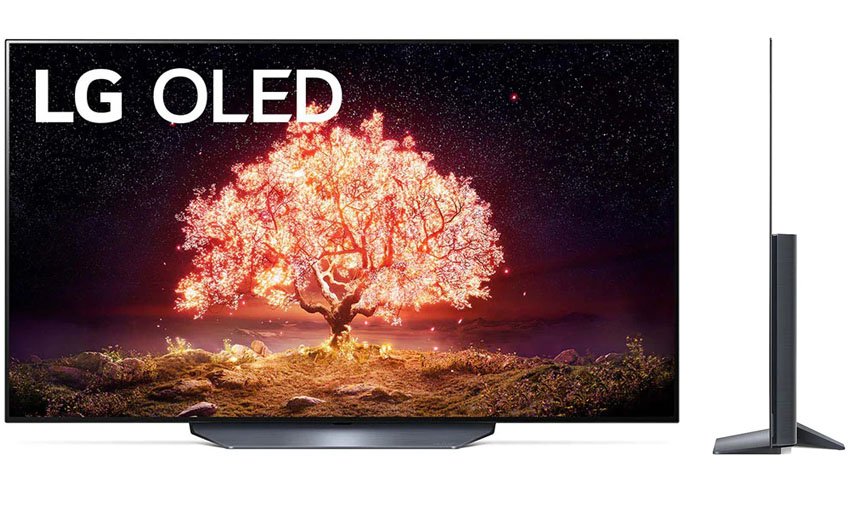
Type : Flat
Once considered the budget friendly OLED it now has given that place to the A1 below. As such the B1 finds itself somewhere in between with the main differences in this one compared to the LG C1 being the less capable a7 Gen 4 AI processor and the inclusion of only two HDMI 2.1 ports instead of four. Everything else remains exactly the same.
Specifications
- 4K resolution (3,840 x 2,160)
- OLED display technology
- 100/120Hz frequency
- a7 Gen 4 AI Processor 4K
- HDR10, HLG and Dolby Vision support
- Dolby Atmos support
- webOS, Airplay 2, Dolby Vision IQ, Game Optimizer, Filmmaker mode, HGiG mode
- 2 x HDMI 2.1, 2 x HDMI 2.0
- ARC / eARC, VRR, FreeSync, G-SYNC, ALLM, HFR
- WiFi5, Bluetooth 5.0
LG A1 (4K OLED TV)

Type : Flat
The LG A1 is the completely new entry in the OLED section in 2021. It is the only OLED that comes with a less capable 50/60Hz panel meaning its motion performance will certainly take a hit while it is also the only OLED not to feature HDMI 2.1 ports. And not only that but we also see a reduction of their number to just three.
You can read our detailed analysis in our LG A1 review.
Specifications
- 4K resolution (3,840 x 2,160)
- OLED display technology
- 50/60Hz frequency
- a7 Gen 4 AI Processor 4K
- HDR10, HLG and Dolby Vision support
- Dolby Atmos support
- webOS, Airplay 2, Dolby Vision IQ, Game Optimizer, Filmmaker mode, HGiG mode
- 3 x HDMI 2.0
- ARC / eARC, ALLM
- WiFi5, Bluetooth 5.0
QNED miniLED Series
LG QNED99 (8K mini LED TV)
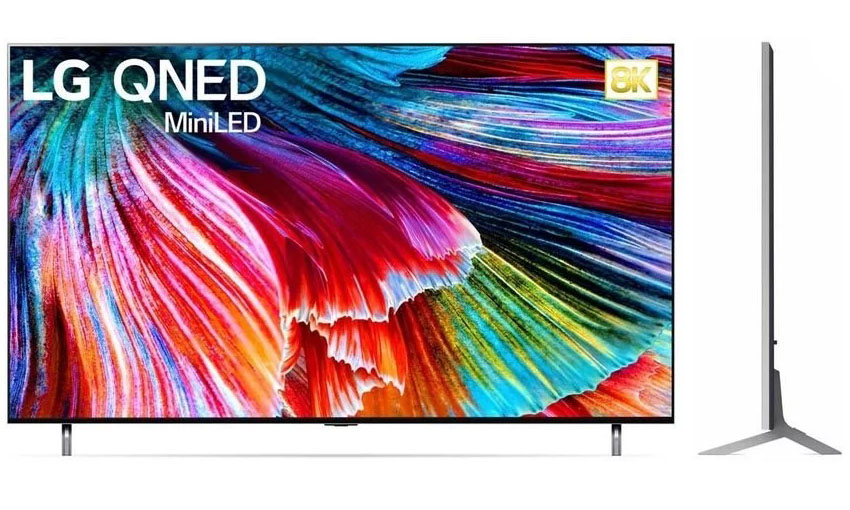
Type : Flat
The QNED lineup is a fresh 2021 entry with the QNED99 sitting at the top. It comes in 8K resolution and features a 100/120Hz IPS panel with a miniLED backlight system that uses 2,500 dimming zones for more accurate light control. Everything else it borrows from the rest of the top OLED models as it comes with the a9 Gen 4 AI processor, features four HDMI 2.1 ports and uses the new webOS 6.0. Unfortunately it does not support VRR technology even though it features the new HDMI ports.
Specifications
- 8K resolution (7,680 x 4,320)
- LED LCD display technology
- mini LED FALD backlight
- IPS panel type
- 100/120Hz frequency
- a9 Gen 4 AI Processor 8K
- HDR10, HLG and Dolby Vision support
- Dolby Atmos support
- webOS, Airplay 2, Dolby Vision IQ, Game Optimizer, Filmmaker mode, HGiG mode
- 4 x HDMI 2.1
- ARC / eARC, ALLM, HFR
- WiFi5, Bluetooth 5.0
LG QNED95 (8K mini LED TV)

Type : Flat
The QNED95 is the second 8K QNED miniLED TV available and this one seems to be exactly the same as the QNED99 in terms of specs. So most probably this is meant for selected regions and comes with the same 100/120Hz IPS panel with a miniLED backlight system that uses 2,500 dimming zones for more accurate light control. It also packs the a9 Gen 4 AI processor, features four HDMI 2.1 ports and uses the new webOS 6.0.
Specifications
- 8K resolution (7,680 x 4,320)
- LED LCD display technology
- mini LED FALD backlight
- IPS panel type
- 100/120Hz frequency
- a9 Gen 4 AI Processor 8K
- HDR10, HLG and Dolby Vision support
- Dolby Atmos support
- webOS, Airplay 2, Dolby Vision IQ, Game Optimizer, Filmmaker mode, HGiG mode
- 4 x HDMI 2.1
- ARC / eARC, ALLM, HFR
- WiFi5, Bluetooth 5.0
LG QNED90 (4K mini LED TV)

Type : Flat
QNED TVs from LG will also come in 4K resolution. The major differences here compared to their 8K counterparts are that this one uses the less capable a7 Gen 4 AI processor and has only 2 HDMI 2.1 ports. The good thing here is that in contrast to its 8K brothers this one supports both VRR and FreeSync for those interested in these features. Everything else remains the same with the top 8K QNEDs.
You can read our full analysis of this TV in our dedicated LG QNED90 review.
Specifications
- 4K resolution (3,840 x 2,160)
- LED LCD display technology
- mini LED FALD backlight
- IPS panel type
- 100/120Hz frequency
- a7 Gen 4 AI Processor 8K
- HDR10, HLG and Dolby Vision support
- Dolby Atmos support
- webOS, Airplay 2, Dolby Vision IQ, Game Optimizer, Filmmaker mode, HGiG mode
- 2 x HDMI 2.1, 2 x HDMI 2.0
- ARC / eARC, ALLM,VRR, FreeSync, HFR
- WiFi5, Bluetooth 5.0
LG QNED85 (4K mini LED TV)

Type : Flat
There is a fourth QNED model, also in 4K resolution called QNED85. There doesn’t seem to be any major differences to this one compared to the QNED90 above and from what info we could get this one seems to be using a less capable 50/60Hz panel. Everything else seems to be the same.
Specifications
- 4K resolution (3,840 x 2,160)
- LED LCD display technology
- mini LED FALD backlight
- IPS panel type
- 50/60Hz frequency
- a7 Gen 4 AI Processor 8K
- HDR10, HLG and Dolby Vision support
- Dolby Atmos support
- webOS, Airplay 2, Dolby Vision IQ, Game Optimizer, Filmmaker mode, HGiG mode
- 2 x HDMI 2.1, 2 x HDMI 2.0
- ARC / eARC, ALLM,VRR, FreeSync, HFR
- WiFi5, Bluetooth 5.0
NanoCell Series
LG NANO99 2021 (8K LED LCD TV)

Type : Flat
With the arrival of the new QNED miniLED TVs it seems that the NanoCell series have been pushed down the performance ladder and from a middle tier category it now approaches a more mid to low tier level. The NANO99 is the best NanoCell LG will be offering and is one of the few 8K NanoCells available this year.
In terms of specs the NANO99 is not all that different from the QNED99. In fact they feature the exact same technologies and their only difference is that the NANO99 is using a traditional full array with local dimming backlight system instead of the much improved mini LED one. Everything else is the same as it uses an IPS 100/120Hz panel, the a9 Gen 4 AI processor 8K and comes with four HDMI 2.1 ports. Unfortunately as with most 8K TVs there is no VRR or FreeSync available here.
Specifications
- 8K resolution (7,680 x 4,320)
- LED LCD display technology
- FALD backlight
- IPS panel type
- 100/120Hz frequency
- a9 Gen 4 AI Processor 8K
- HDR10, HLG and Dolby Vision support
- Dolby Atmos support
- webOS, Airplay 2, Dolby Vision IQ, Game Optimizer, Filmmaker mode, HGiG mode
- 4 x HDMI 2.1
- ARC / eARC, ALLM, HFR
- WiFi5, Bluetooth 5.0
LG NANO96 2021 (8K LED LCD TV)

Type : Flat
The NANO96 is still an 8K TV and it will be released in selected markets while looking at the specs we conclude that this is extremely similar to the NANO99 spec wise. The only downgrade we find in this one is that it uses a 50/60Hz panel. It also comes with a central stand instead of the usual bench type design.
Specifications
- 8K resolution (7,680 x 4,320)
- LED LCD display technology
- FALD backlight
- IPS panel type
- 50/60Hz frequency
- a9 Gen 4 AI Processor 8K
- HDR10, HLG and Dolby Vision support
- Dolby Atmos support
- webOS, Airplay 2, Dolby Vision IQ, Game Optimizer, Filmmaker mode, HGiG mode
- 4 x HDMI 2.1
- ARC / eARC, ALLM, HFR
- WiFi5, Bluetooth 5.0
LG NANO95 2021 (8K LED LCD TV)

Type : Flat
The NANO95 is exactly the same as the NANO96 but uses a bench type stand instead. All other specifications are exactly the same. The NANO95, along with the NANO96 which is virtually the same TV, are the most affordable 8K TVs LG will be selling this year. So if you absolutely want an 8K model but want to go cheap these are the ones to look for.
Specifications
- 8K resolution (7,680 x 4,320)
- LED LCD display technology
- FALD backlight
- IPS panel type
- 50/60Hz frequency
- a9 Gen 4 AI Processor 8K
- HDR10, HLG and Dolby Vision support
- Dolby Atmos support
- webOS, Airplay 2, Dolby Vision IQ, Game Optimizer, Filmmaker mode, HGiG mode
- 4 x HDMI 2.1
- ARC / eARC, ALLM, HFR
- WiFi5, Bluetooth 5.0
LG NANO92 2021 (4K LED LCD TV)

Type : Flat
The NANO92 is one of the few similar variants that come in 4K resolution and compared to the above NanoCells we get a 100/120Hz panel, the a7 Gen 4 AI processor 4K and only two HDMI 2.1 ports. On the other side we once again find VRR and FreeSync support if you are into gaming and need one of them.
Specifications
- 4K resolution (3,840 x 2,160)
- LED LCD display technology
- FALD backlight
- IPS panel type
- 100/120Hz frequency
- a7 Gen 4 AI Processor 4K
- HDR10, HLG and Dolby Vision support
- Dolby Atmos support
- webOS, Airplay 2, Dolby Vision IQ, Game Optimizer, Filmmaker mode, HGiG mode
- 2 x HDMI 2.1, 2 x HDMI 2.0
- ARC / eARC, ALLM, VRR, FreeSync, HFR
- WiFi5, Bluetooth 5.0
LG NANO91 2021 (4K LED LCD TV)

Type : Flat
The NANO91 is like for like with the NANO92 above and this is meant for specific markets. No differences with the above NanoCell whatsoever.
Specifications
- 4K resolution (3,840 x 2,160)
- LED LCD display technology
- FALD backlight
- IPS panel type
- 100/120Hz frequency
- a7 Gen 4 AI Processor 4K
- HDR10, HLG and Dolby Vision support
- Dolby Atmos support
- webOS, Airplay 2, Dolby Vision IQ, Game Optimizer, Filmmaker mode, HGiG mode
- 2 x HDMI 2.1, 2 x HDMI 2.0
- ARC / eARC, ALLM, VRR, FreeSync, HFR
- WiFi5, Bluetooth 5.0
LG NANO90 2021 (4K LED LCD TV)

Type : Flat
The NANO90 is the last of the trio of similar models with the others being the NANO91 and NANO92. The only difference in this one is in its design as this one comes with a bench type stand. Spec wise everything remains the same.
Keep in mind that these three models, the NANO90, NANO91 and NANO92 are the most affordable units that feature a FALD backlight system.
Specifications
- 4K resolution (3,840 x 2,160)
- LED LCD display technology
- FALD backlight
- IPS panel type
- 100/120Hz frequency
- a7 Gen 4 AI Processor 4K
- HDR10, HLG and Dolby Vision support
- Dolby Atmos support
- webOS, Airplay 2, Dolby Vision IQ, Game Optimizer, Filmmaker mode, HGiG mode
- 2 x HDMI 2.1, 2 x HDMI 2.0
- ARC / eARC, ALLM, VRR, FreeSync, HFR
- WiFi5, Bluetooth 5.0
LG NANO88 2021 (4K LED LCD TV)
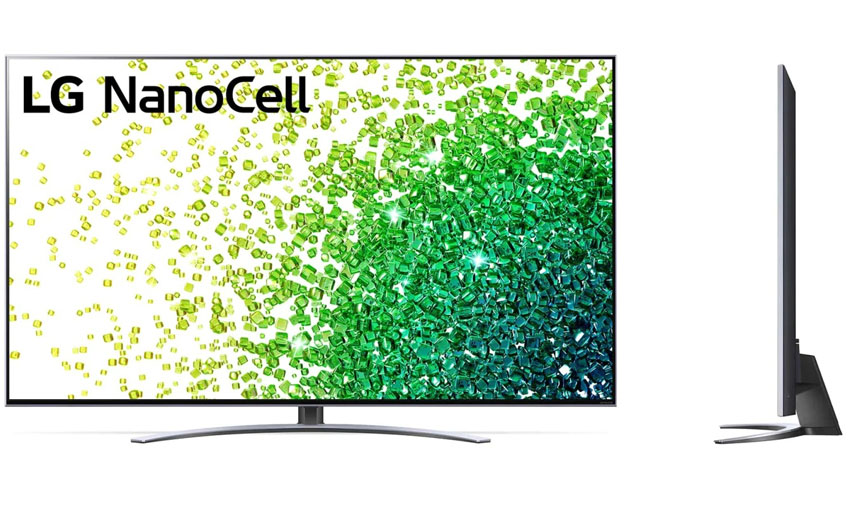
Type : Flat
Next we get another trio of similar TVs with the first one being the NANO88. The only downgrade compared to the NanoCells above is that we switch to an Edge LED backlight system which means less accurate light control. Everything else is the same with a 100/120Hz IPS panel, an a7 Gen 4 AI processor 4K and two HDMI 2.1 ports. VRR and FreeSync are still available here.
Specifications
- 4K resolution (3,840 x 2,160)
- LED LCD display technology
- Edge LED backlight
- IPS panel type
- 100/120Hz frequency
- a7 Gen 4 AI Processor 4K
- HDR10, HLG and Dolby Vision support
- Dolby Atmos support
- webOS, Airplay 2, Dolby Vision IQ, Game Optimizer, Filmmaker mode, HGiG mode
- 2 x HDMI 2.1, 2 x HDMI 2.0
- ARC / eARC, ALLM, VRR, FreeSync, HFR
- WiFi5, Bluetooth 5.0
LG NANO86 2021 (4K LED LCD TV)

Type : Flat
The NANO86 is the second release from the trio of similar TVs and this one seems to have slightly different color and will be sold in selected markets. Everything else is exactly the same as the NANO88 above.
Specifications
- 4K resolution (3,840 x 2,160)
- LED LCD display technology
- Edge LED backlight
- IPS panel type
- 100/120Hz frequency
- a7 Gen 4 AI Processor 4K
- HDR10, HLG and Dolby Vision support
- Dolby Atmos support
- webOS, Airplay 2, Dolby Vision IQ, Game Optimizer, Filmmaker mode, HGiG mode
- 2 x HDMI 2.1, 2 x HDMI 2.0
- ARC / eARC, ALLM, VRR, FreeSync, HFR
- WiFi5, Bluetooth 5.0
LG NANO85 2021 (4K LED LCD TV)
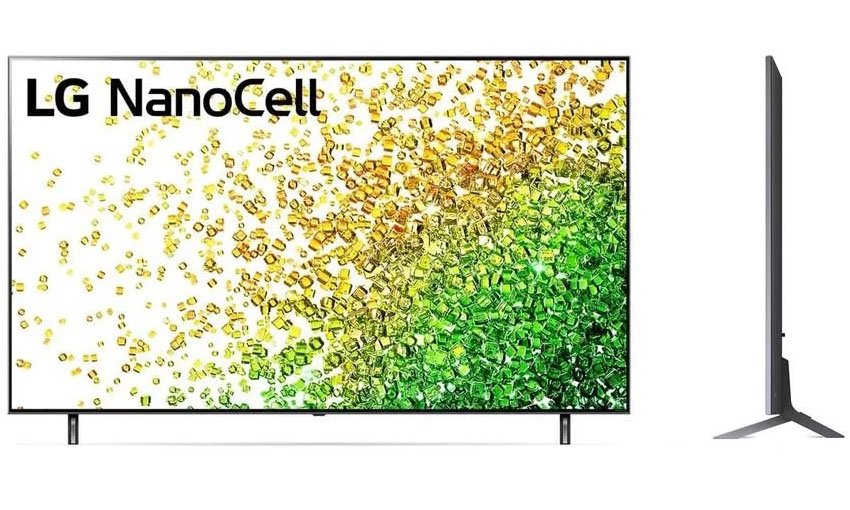
Type : Flat
The last of the trio of NanoCells with similar specs and the difference in the NANO85 is that it uses a bench type design. All other specs are unchanged. Keep in mind that the trio of the NANO85, NANO86 and NANO88 are the last ones that use the a7 Gen 4 AI processor 4K. Everything else below these use less capable image processing chips.
Specifications
- 4K resolution (3,840 x 2,160)
- LED LCD display technology
- Edge LED backlight
- IPS panel type
- 100/120Hz frequency
- a7 Gen 4 AI Processor 4K
- HDR10, HLG and Dolby Vision support
- Dolby Atmos support
- webOS, Airplay 2, Dolby Vision IQ, Game Optimizer, Filmmaker mode, HGiG mode
- 2 x HDMI 2.1, 2 x HDMI 2.0
- ARC / eARC, ALLM, VRR, FreeSync, HFR
- WiFi5, Bluetooth 5.0
LG NANO81 2021 (4K LED LCD TV)

Type : Flat
Next in line we find a couple of similar NanoCells with some pretty major reductions compared to the ones we saw above them. First of all the NANO81 is using a 50/60Hz panel and changes to a quad core processor. Dolby is missing completely from these ones and as a result we loose Dolby Vision, Dolby Vision IQ and Dolby Atmos support. Lastly there is no HDMI 2.1 here and instead we have to settle with four HDMI 2.0 ports.
Specifications
- 4K resolution (3,840 x 2,160)
- LED LCD display technology
- Edge LED backlight
- IPS panel type
- 50/60Hz frequency
- Quad Core Processor
- HDR10 and HLG support
- webOS, Airplay 2, Game Optimizer, Filmmaker mode, HGiG mode
- 4 x HDMI 2.0
- ARC / eARC, ALLM
- WiFi5, Bluetooth 5.0
LG NANO80 2021 (4K LED LCD TV)

Type : Flat
The NANO80 is exactly the same as the NANO81 in specs and they are only different in the stand they use as this one goes for a bench type design.
Specifications
- 4K resolution (3,840 x 2,160)
- LED LCD display technology
- Edge LED backlight
- IPS panel type
- 50/60Hz frequency
- Quad Core Processor
- HDR10 and HLG support
- webOS, Airplay 2, Game Optimizer, Filmmaker mode, HGiG mode
- 4 x HDMI 2.0
- ARC / eARC, ALLM
- WiFi5, Bluetooth 5.0
LG NANO77 (4K LED LCD TV)

Type : Flat
The NANO77 is having two reductions compared to the NANO80 above. First of all we get a Direct LED backlight and we find three HDMI ports instead of four. Also the NANO77 is coming in a unique white color.
Specifications
- 4K resolution (3,840 x 2,160)
- LED LCD display technology
- Direct LED backlight
- IPS panel type
- 50/60Hz frequency
- Quad Core Processor
- HDR10 and HLG support
- webOS, Airplay 2, Game Optimizer, Filmmaker mode, HGiG mode
- 3 x HDMI 2.0
- ARC / eARC, ALLM
- WiFi5, Bluetooth 5.0
LG NANO75 (4K LED LCD TV)
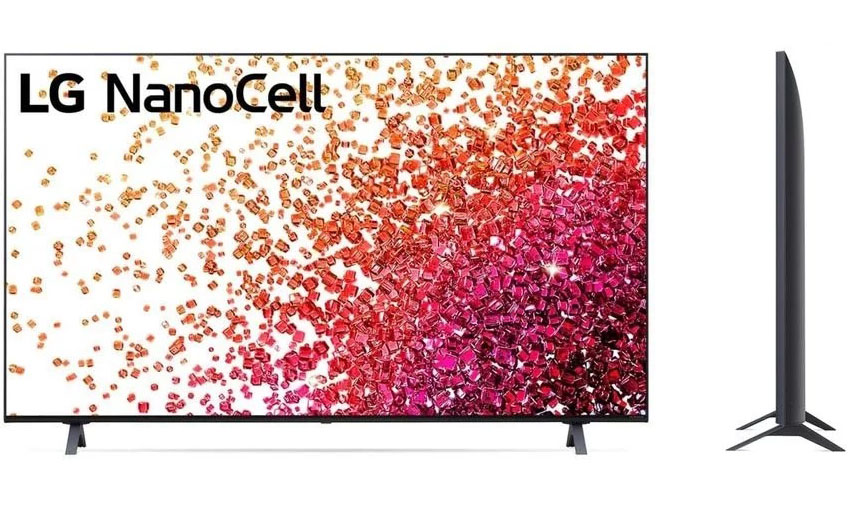
Type : Flat
The last of the NanoCells, the NANO75 is no different to the NANO77 above. The only meaningful difference is the different body color as this one goes for a black color instead of a white one.
Specifications
- 4K resolution (3,840 x 2,160)
- LED LCD display technology
- Direct LED backlight
- IPS panel type
- 50/60Hz frequency
- Quad Core Processor
- HDR10 and HLG support
- webOS, Airplay 2, Game Optimizer, Filmmaker mode, HGiG mode
- 3 x HDMI 2.0
- ARC / eARC, ALLM
- WiFi5, Bluetooth 5.0
UHD TV Series
LG UP81 (4K LED LCD TV)

Type : Flat
Except from the NanoCell series LG will also offer a series of low cost UHD TVs. The first of them is the UP81 which is essentially the same as the NANO75 above and the only real difference is that here we loose the NanoCell technology that is responsible of creating more lifelike colors. As a result color coverage and reproduction will certainly take a hit.
Specifications
- 4K resolution (3,840 x 2,160)
- LED LCD display technology
- Direct LED backlight
- IPS panel type
- 50/60Hz frequency
- Quad Core Processor
- HDR10 and HLG support
- webOS, Airplay 2, Game Optimizer, Filmmaker mode, HGiG mode
- 3 x HDMI 2.0
- ARC / eARC, ALLM
- WiFi5, Bluetooth 5.0
LG UP80 (4K LED LCD TV)

Type : Flat
As we have seen many times in LGs lineup once again we see a similar model with a different stand. As such the UP80 is exactly the same as the UP81 above but instead of the central stand we get the bench type variant.
One thing that we should note is that the 82″ and 86″ sizes use a 100/120Hz panel and come with α7 Gen4 Processor 4K. Also the 50″,60″ and 70″ use VA panels instead of the ADS ones found in the other sizes. At the time of writing we could confirm this variants to apply for the UP80 but we could not confirm if the same differences apply to other similar models like the UP81.
You can read our full analysis of the UP8000 HERE.
Specifications
- 4K resolution (3,840 x 2,160)
- LED LCD display technology
- Direct LED backlight
- IPS panel type (50, 60″, 70″ use VA panel)
- 50/60Hz frequency (82″, 86″ have 100/120Hz frequency)
- Quad Core Processor (82″, 86″ come with α7 Gen4 Processor 4K)
- HDR10 and HLG support
- webOS, Airplay 2, Game Optimizer, Filmmaker mode, HGiG mode
- 3 x HDMI 2.0 (82″, 86″ have 2 x HDMI 2.1, 2 x HDMI 2.0)
- ARC / eARC, ALLM
- WiFi5, Bluetooth 5.0
LG UP78 (4K LED LCD TV)
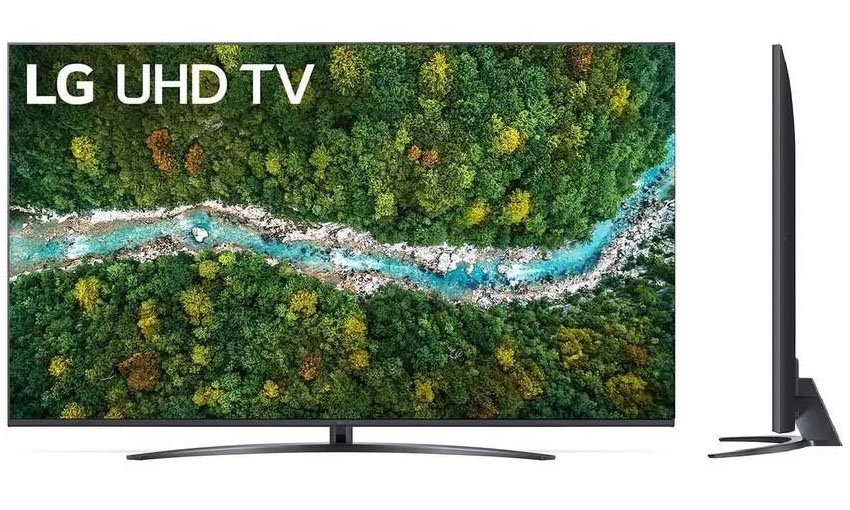
Type : Flat
Next there are four UHD TVs with similar specs and the only differences between them seems to be designs, colors and stands. Their only real difference with the above UHD TVs is that these ones come with only two HDMI 2.0 ports.
Specifications
- 4K resolution (3,840 x 2,160)
- LED LCD display technology
- Direct LED backlight
- IPS panel type
- 50/60Hz frequency
- Quad Core Processor
- HDR10 and HLG support
- webOS, Airplay 2, Game Optimizer, Filmmaker mode, HGiG mode
- 2 x HDMI 2.0
- ARC / eARC, ALLM
- WiFi5, Bluetooth 5.0
LG UP77 (4K LED LCD TV)

Type : Flat
The UP77 is the same as the UP78 with a slightly different design and will be released in selected markets.
Specifications
- 4K resolution (3,840 x 2,160)
- LED LCD display technology
- Direct LED backlight
- IPS panel type
- 50/60Hz frequency
- Quad Core Processor
- HDR10 and HLG support
- webOS, Airplay 2, Game Optimizer, Filmmaker mode, HGiG mode
- 2 x HDMI 2.0
- ARC / eARC, ALLM
- WiFi5, Bluetooth 5.0
LG UP76 (4K LED LCD TV)

Type : Flat
Another UHD TV variant, the UP76 comes in a unique white color with a more bulky body design.
Specifications
- 4K resolution (3,840 x 2,160)
- LED LCD display technology
- Direct LED backlight
- IPS panel type
- 50/60Hz frequency
- Quad Core Processor
- HDR10 and HLG support
- webOS, Airplay 2, Game Optimizer, Filmmaker mode, HGiG mode
- 2 x HDMI 2.0
- ARC / eARC, ALLM
- WiFi5, Bluetooth 5.0
LG UP75 (4K LED LCD TV)

Type : Flat
The last of the similar UHD TV models, the UP75 uses once again a black body color and a bench type design. One major difference is that the UP75 is using a simple remote instead of the MR21 Magic Remote we find in all LG TVs above.
Specifications
- 4K resolution (3,840 x 2,160)
- LED LCD display technology
- Direct LED backlight
- IPS panel type
- 50/60Hz frequency
- Quad Core Processor
- HDR10 and HLG support
- webOS, Airplay 2, Game Optimizer, Filmmaker mode, HGiG mode
- 2 x HDMI 2.0
- ARC / eARC, ALLM
- WiFi5, Bluetooth 5.0
LG UP70 (4K LED LCD TV)

Type : Flat
The last of the 4K TVs from LG. The only change in this one is that it doesn’t have Bluetooth functionality. Everything else seems to be exactly the same as above. This is as cheap as it gets in terms of 4K resolution TVs so in case you want to go as cheap as possible the UP70 is the one to look for.
Specifications
- 4K resolution (3,840 x 2,160)
- LED LCD display technology
- Direct LED backlight
- IPS panel type
- 50/60Hz frequency
- Quad Core Processor
- HDR10 and HLG support
- webOS, Airplay 2, Game Optimizer, Filmmaker mode, HGiG mode
- 2 x HDMI 2.0
- ARC / eARC, ALLM
- WiFi5
Sony TVs 2021

Now that’s a huge lineup they have there. For some reason I always favored LG over other brands and they certainly haven’t failed me yet. I have a C9 and I am really happy with it. But I love looking what new is coming every year. You did great work putting everything together. The table you made that show everything together is really helpful to understand their differences.
I am glad you liked the way we made everything. It’s important in such articles where a lot of releases are grouped together to be able to make them easy to understand by out readers. If you have any suggestion for further improvements let us know.
Good to see the cheaper LG A1 that will guarantee the affordability of OLED TVs for people who only want to go small with OLED! I can’t wait to get the 83 inches screen size as soon as I can. I love bigger screens and would love to go for the LG since I have heard good thing about their gaming capabilities. The Z1 looks amazing but the price is really out of this world.
Hey there. Indeed the A1 will certainly make a lot of people go for it even if its specs is not up to par with the rest of the OLEDs. It still has the deep blacks of an OLED TV and this will certainly work to its advantage.